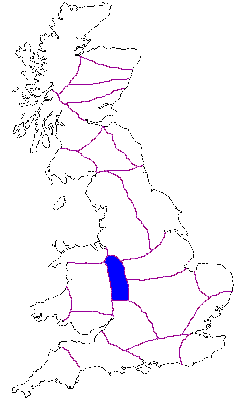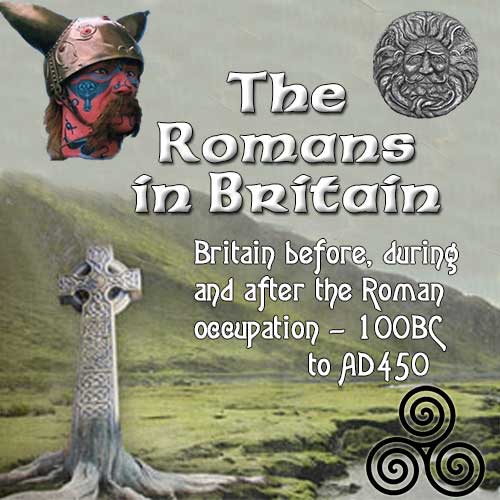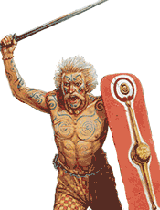The Cornovii tribe
Background to the Cornovii
T he Cornovii were a Celtic people
of Iron Age and Roman Britain, who lived principally in the modern English counties of Cheshire,
Shropshire, north Staffordshire, north Herefordshire and eastern parts of the Welsh county of Powys.
Their capital in pre-Roman times was probably a hill fort on The Wrekin. Ptolemy's 2nd century
Geography names two of their towns: Deva Victrix (Chester), and Viroconium Cornoviorum
(Wroxeter), which became their capital under Roman rule.
he Cornovii were a Celtic people
of Iron Age and Roman Britain, who lived principally in the modern English counties of Cheshire,
Shropshire, north Staffordshire, north Herefordshire and eastern parts of the Welsh county of Powys.
Their capital in pre-Roman times was probably a hill fort on The Wrekin. Ptolemy's 2nd century
Geography names two of their towns: Deva Victrix (Chester), and Viroconium Cornoviorum
(Wroxeter), which became their capital under Roman rule.
Their territory was bordered by the Brigantes to the North, the Corieltauvi to the East, the Dobunni to the South, and the Deceangli, and Ordovices to the West.
The people who inhabited the very north of the British mainland (modern Caithness), and Cornwall were also known by the same name, but according to mainstream or academic opinion were quite separate and unrelated peoples.
The problem of tribal nomenclature
The first mention of the tribe occurs in the works of Ptolemy in the 2nd century A.D.:
- "From these¹ toward the east are the Cornavi, among whom are the towns: Deva,² Legio XX Victrix 17*30 56°45, Viroconium³ 16*45 55°45." (Ptolemy Geographia II.ii)
The name itself may mean "People of the Horn". Graham Webster in The Cornovii (1991) cites Anne Ross's hypothesis that the tribal name(s) may be totemic cult-names referring to a "horned god" cult followed by the tribe(s). There is no direct evidence of this; however, Webster points out that it is interesting that at Abbot's Bromley the "horn dance" has survived from pagan ritual—Abbot's Bromley being only 55 km north east of the old tribal centre at Wroxeter (Virconium Cornoviorum). In addition, Webster quotes Professor Charles Thomas as having made a "good case" for such totemic ethnonyms in Scotland.
Archaeological evidence
The Cornovii produced little in the way of identifiable ceramic wares. Their sites are identified by construction details of their hill forts and metalwork artifacts. The Cornovi built numerous hill forts, including Titterstone Clee near Bitterley. Old Oswestry hill fort is also thought to have been inhabited by the Cornovii. One of these hill forts is probably that referred to by the historian Tacitus as the last refuge of the resistance led by Caratacus in 50 AD. However, the nature of hill forts is strongly contested among archaeologists, with some crediting them only as tribal status symbols or cattle stockades rather than defended settlements.
The tribe developed no known coinage, but their control of the south-Cheshire salt-making industry and parts of its distribution network probably gave them a fair degree of wealth, multiplied by trading and cattle breeding. However, their economy was mainly a pastoral one. Since the early Iron Age they had had a network of paved and semi-paved roads good enough to transport their famous chariots.
It should not be assumed that the Cornovii looked like paint-daubed savages; the Romans, who described the British as "vain", noted their attention to appearance and personal hygiene. Gold and bronze torcs (i.e.: heavy necklaces made of twisted strands of metal) have been found at Iron Age sites in the region. They were expert in weaving and dyeing, and loved bright colours. Women wore their hair in two thick thigh-length plaits.
The tomb of Vedica, a Cornovian woman
The tombstone of a thirty-year-old woman of the Cornovii called Vedica was found at Ilkley in Yorkshire outside of known Cornovii territory.
- DIS MANIBVS VEDIC [...] RICONIS FILIA ANNORVM XXX C CORNOVIA H S E
- "To the spirits of the departed and to Vedica,¹ thirty years old, daughter of Virico² of the Cornovii;³ she lies here."
This is the only epigraphic evidence of civilian occupation at Ilkley (Roman Verbeia). Vedica may possibly have been the daughter of a chieftain "Viroco" of the Cornovii, who was killed during the western expansion of early 47 AD commanded by Publius Ostorius Scapula.
Pre-Roman history
Prior to the Roman invasion of Cornovian territory in 47 AD the most significant Cornovian hillforts known were those at Titterstone Clee near Bitterley, being the only one excavated to date, Chesterton Walls near Romsley and Bury Walls near Weston-under-Redcastle. Other hillforts of Iron Age Cornovii include the Wrekin hillfort near Wellington, Caynham Camp near Poughnhill and Old Oswestry. All of these camps are in the county of Shropshire but there was another significant settlement at the Breiddin hillfort in Powys.
Some suggest that a lack of metal and fine pottery finds may be indicative that the Cornovii were not a particularly wealthy or sophisticated British tribe and that they depended mostly on a pastoral economy even though some cultivation of cereal crops appears to have occurred in the river valley areas. These aforeseaid lowland areas seem to have been populated by rural peasants who were obliged to pay tribute in cattle and grain to the local chieftains resident in the hillforts.
Roman period
The tribal civitas capital was Viroconium Cornoviorum (or simply "Viroconium"), the fourth largest town in Roman Britain. It started life as a legionary fortress in the mid-1st century, possibly garrisoned by the XIV Legion then the XX Legion. The main section of Watling Street runs from Dubrium (Dover) to Viroconium (Wroxeter). The place-name itself is suggestive of the Wrekin hillfort, overlooking the site from the east. The Cornovii seem to have had many hillforts, the largest and most populous being that at the Wrekin near the site of the Romano-British tribal capital.
The eventual size of Viroconium is inconsistent with the estimated population size, taken from the number of known pre-Roman settlements in the area; the archaeological evidence suggests a sparsely populated region. Perhaps the majority of the population lived in timber hut-dwellings without stone foundations, making it more difficult to find archaeological trace. There are, however, impressive standing Roman ruins from Viroconium just outside the modern day village of Wroxeter.
By the time the city had become fully established as a civitas capital, Viroconium had seen great expansion, with all the usual trappings of a classical Roman settlement including the forum basilica, shops and, of course, the baths. Both the massive structural remains of the baths and exercise yard found during archaeological excavations and subsequent research indicate that Viroconium's most prosperous era was between the 2nd and 3rd centuries, and demonstrate the success of this regional economic centre. Nevertheless it appears that by the 4th century the area was already starting to decline.
Viroconium Cornoviorum and Calleva Atrebatum (Silchester) seem to be the only major Roman settlements in Britain that, subsequently, did not grow into larger towns or cities in the post-Roman period. This may have been due to the foundation of Shrewsbury (probably in the 9th century) nearby, which was more easily defended, although the village of Wroxeter still continued to grow.
Owing to little development in the Wroxeter area, much of the Roman material has survived reasonably intact compared to other parts of Britain. This has led to the town becoming a favourite among archaeologists and students of Roman Britain.
Cohors Primae Cornoviorum
The Cohors Primae Cornoviorum was the only recorded native British unit known to have served in Britannia. The I Cohort of Cornovii were recruited from the tribe itself, thus bearing the name "Cornoviorum", i.e. "of the Cornovii". The strength of this military unit is unknown. The cohort was an infantry unit and is likely to have numbered only 500. The units formed the late 4th century garrison of Pons Aelius (Newcastle-upon-Tyne) at the eastern terminus of Hadrian's Wall. This is recorded in the Notitia Dignitatum.
Posting stations, settlements and military stations
- Bovium (Tilston, Cheshire) - Named in the Antonine Itinerary, the site of the potteries and tile factory of Legio XX Valeria, just south of Chester.
- Wilderspool (nr. Warrington, Cheshire) - Minor settlement on the south bank of the River Dean near its confluence with the Mersey.
- Heronbridge (Cheshire) - On the west bank of the River Dee immediately south of Chester.
- Ffridd (Clwyd) - Fort and substantial Roman constructions near the border with the Deceangli.
- Bravonium (Leintwardine, Hereford & Worcester) - Small roadside town and important military complex on Watling Street West, S of Wroxeter in the Welsh Marches.
- Uxacona (Red Hill[disambiguation needed
 ], nr. Oakengates, Shropshire) - Small
settlement on Watling Street, east of Wroxeter.
], nr. Oakengates, Shropshire) - Small
settlement on Watling Street, east of Wroxeter. - Pennocrucium (Water Eaton) - Small town and military complex on Watling Street, S of Penkridge.f an administrative pagus, with a substantial public bath-house and a mansio.
- Knighton - Its possible this settlement was created when pre Offa's Dyke earth mounds were built by the Romans.
- Rutunium (Harcourt Park, Shropshire) - A small settlement and posting station on the road north between the military bases at Wroxeter and Chester, at the crossing of the River Roden.
- Mediolanum (Whitchurch) (Shropshire) - Romano-British settlement, whose modern street plan suggests a small walled town.
- Salinae (Middlewich, Cheshire) - Salt manufacturing town.
- Condate (Northwich, Cheshire) - Salt works probable.
- Levobrinta (Forden Gaer, Powys) - This military site possibly marked the SW border of the Cornovian canton.
- Chesterton (nr. Newcastle-under-Lyme, Staffordshire) - Small town built on the site of a possible earlier Neronian fort, on the road from Middlewich to Derby.
- Rocester (North Staffordshire) - Small town built on the site of an earlier Flavian fort on the Cornovian borders, with the Brigantes to the north and the Corieltauvi to the east.
- Malpas, Cheshire - Small settlement on the Whitchurch - Chester road.
Post-Roman history
After Roman occupation, the lands of the Cornovii became a centre of military and economic operations. Viroconium Cornoviorum became one of the most important cities in Roman Britain, where Legio XIV Gemina was garrisoned for some time. The Romans also exploited metals such as copper, lead and silver in the area. Some Romanised Cornovii are known to have served as Roman legionaries.
The 5th century saw continued town life in Viroconium but many of the buildings fell into disrepair. However, between 530 and 570 there was a substantial rebuilding programme in timber with most of the old basilica being demolished and replaced with new buildings. These probably included a very large two-story timber-framed building and a number of storage buildings and houses. In all, 33 new buildings were constructed. The archaeologists responsible for the most recent excavations comment that "their construction was carefully planned and executed..." and "were skillfully constructed to Roman measurements using a trained labour force". Who instigated this rebuilding program is not known, although it may have been a bishop. Some of the buildings were renewed three times and the community probably lasted about 75 years until for some reason many of the buildings were dismantled.
Dark Age period
After this period, and with the relentless expansion of Anglian power in the English Midlands, the Cornovian tribal area came under the rule of the Kingdom of Pengwern. Following a period of military alliance with Mercian rulers, particularly King Penda, Pengwern was absobed by neighbouring Mercia after 642 AD. The local Cornovian people may have continued to reside in the area, perhaps as the Wrekensaete, under Mercian rule.
The site of the Roman city of Viroconium Cornoviorum is known in Old Welsh as Caer Guricon. As Caer Guricon it may have served as capital of the Kingdom of Powys during the sub-Roman period until Anglo-Saxon pressures in the form of Mercian encroachment forced the British to relocate to Mathrafal castle sometime before 717 AD. Pengwern and Powys themselves may have been later divisions of the pre-Roman Cornovii tribal territory whose civitas was Viroconium Cornoviorum. With the passage of time the lesser Magonsæte sub-kingdom also emerged in this area during the period between Powys and Mercian rule.
The Morris theory: link to Cornwall
Although not widely accepted by modern scholarship John Morris's theory deals with the hypothetical link between the Midlands Cornovii and later Cornwall. In The Age of Arthur, 1973, Morris discussed the Wroxeter dynasty of Constantine whose name is found, albeit indirectly, in a reference by Gildas to Constantine as tyrant whelp of the filthy lioness of Dumnonia i.e. the current areas of Devon, Cornwall and part of Somerset. According to this theory, the principal Cornovian families of Viroconium may have moved to Dumnonia, sometime around 430 AD.
Morris goes on to mention one Ducco, who is also known as Congar, (d. 473 AD) as a monk on the estate that he had also established there. Morris asserts that the latter name is that which is preserved in the modern name of Congresbury, Somerset, south of Bristol. The Cadbury-Congresbury fortification is the only major fortification in Wales and "Dumnonia" to have produced reasonable evidence for continuous occupation from the 3rd century to the sixth.
Wanborough, Wiltshire
In Roman times the settlement at Wanborough was known as Durocornovium and was a little north west of the current position, at a road junction mentioned in the Antonine Itinerary. Being the last vicus on Ermin Street before the scarp slope of the Marlborough Downs, Durocornovium was a site where horses were watered before the steep climb off the Oxfordshire plain. It is not obvious why this name was used as it is a long way from the territories of the two Cornovii tribes.
*As this site originally did not have any info on this tribe, we turned to the good old standby of Wikipedia!! http://en.wikipedia.org/wiki/Cornovii_%28Midlands%29























